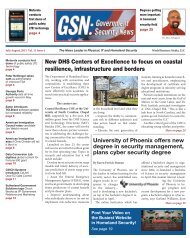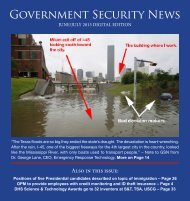October/November 2015 Digital Edition
Create successful ePaper yourself
Turn your PDF publications into a flip-book with our unique Google optimized e-Paper software.
Intelligent Video Surveillance<br />
NSF support: tool that predicts<br />
perceived video quality<br />
Continued from page 27<br />
difference.”<br />
The Structural SIMilarity (SSIM)<br />
index is a method for measuring the<br />
similarity between a compressed image<br />
or video and the uncompressed<br />
original, in terms of human<br />
perception. Today,<br />
SSIM is part of the technological<br />
toolkit used by<br />
most major broadcasters<br />
and cable and satellite<br />
companies around the<br />
world, including AT&T,<br />
Comcast, NBC, FOX and<br />
PBS.<br />
Technology manufacturers<br />
such as Cisco, Motorola<br />
(Arris), Intel and<br />
Texas Instruments rely<br />
on SSIM to ensure the<br />
broadcast, networking<br />
and TV equipment they produce<br />
maintains the best possible video<br />
quality.<br />
When Bovik and his team started<br />
working on the issue of predicting<br />
how people would perceive video<br />
quality, they faced some difficult<br />
challenges. At the time, state-ofthe-art<br />
prediction algorithms either<br />
did not account for how humans<br />
perceive distorted images, or were<br />
too computationally intensive to<br />
be practical. Drawing from neuroscience<br />
models of low-level vision,<br />
the SSIM model disruptively solved<br />
both problems by providing the<br />
world’s best solution to the video<br />
quality prediction problem at at a<br />
low computational cost.<br />
“The first breakthrough was a<br />
very simple model developed by an<br />
advanced graduate student, Zhou<br />
Wang and myself called Universal<br />
Quality Index. We later developed<br />
the final SSIM model with another<br />
grad student (Hamid Sheikh) and<br />
our NYU collaborator, Professor<br />
Eero Simoncelli,” Bovik said.<br />
The students’ efforts were critical,<br />
Bovik said, particularly Wang’s<br />
development of the efficient SSIM<br />
model and Sheikh’s NSF-supported<br />
large-scale human study of picture<br />
quality.<br />
“NSF support of graduate students<br />
28<br />
is a major reason for the success of<br />
many research projects,” Bovik said.<br />
Early in Bovik’s academic career-<br />
-back in the mid-1980s--he began<br />
collaborating with visual psychologists<br />
and neuroscientists to better<br />
understand perception. In the process,<br />
he became an accomplished vision<br />
scientist.<br />
With support from<br />
NSF, he applied discipline-crossing<br />
theories<br />
about how humans see<br />
and perceive objects and<br />
motion, and used them<br />
to accurately assess how<br />
naturalistic or distorted<br />
an image or video would<br />
appear to a human viewer.<br />
Among the insights<br />
from visual perception<br />
theory that the SSIM<br />
model incorporates are:<br />
Contrast masking, where the<br />
texture or “busyness” causes image<br />
distortions to become less perceptible.<br />
Luminance masking, whereby<br />
distortion is less visible in brighter<br />
regions.<br />
And structural similarity, the<br />
idea that visually important structures,<br />
such as edges and details, are<br />
modified or destroyed by compression,<br />
which can also give rise to new<br />
“false” structures that are perceived
















